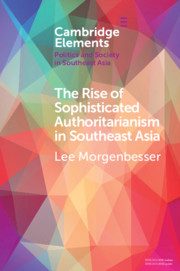Element contents
The Rise of Sophisticated Authoritarianism in Southeast Asia
Published online by Cambridge University Press: 22 April 2020
Summary
Keywords
- Type
- Element
- Information
- Online ISBN: 9781108630061Publisher: Cambridge University PressPrint publication: 16 April 2020
Bibliography
- 42
- Cited by

